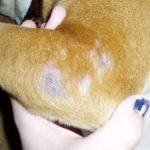Most of us have seen mange on shows like Animal Cops and think of it as something that only severely neglected dogs get. Imagine my surprise then, when a few years ago I adopted a 5 month old sheltie secondhand from a reputable breeder and she got mange. When I took her to the vet I learned some interesting facts about manage, which I believe all dog owners should know.
Dr. Roger Poole, VMD, is a graduate of the prestigious University of Pennsylvania School of Veterinary Medicine and operates both Fair Haven Animal Hospital in Fair Haven, NJ and Colonial Veterinary Clinic in Colts Neck, NJ. He nicely answered our questions on this horrible skin disease.
What is Manage and How do Dog’s Get it?
There are two types of mange that affect canines (dogs). Demodectic Mange, also known as Red Mange or Spectacle disease because it sometimes appears as redness or rash like around the dog’s face and eyes is a mite disease. The mites are pretty much present on every dog and most people, but it is not transmissible between species meaning a dog cannot give the disease to a human. It is largely a young dog’s disease but there is a risk to older dogs whose immunity are compromised.


Sarcoptic Mange, also known as Scabies, is transmissible, but it is not highly contagious to humans. Sarcoptic mange is more difficult to diagnose because the mites are more difficult to see, even in a scraping, but it does have a suspicious smell connected with it that can help veterinarians in detecting the disease. There is a hereditary component to Sarcoptic Mange, meaning if the mother had the disease as a young dog and recovered, her puppies are more likely to get mange as adults. Therefore it is not recommended to breed dogs that suffer from Sarcoptic mange.
Can You Prevent Mange?
Demodectic Mange is avoided by maintaining the dog’s immune system with good care and regular health checks. Sarcoptic Mange can be contracted through contact with other dogs with mange or wildlife that has mange so it’s best to try and keep your dog’s exposure to wildlife at a minimum. It’s often the case that foxes, coyotes and other wild animals can die of Sarcoptic Mange without treatment so it should be treated seriously.
Mange becomes a problem when the mites produce at a higher rate than normal and it creates an extremely perritic (itchy) condition in a dog. The itching can be extremely irritating and causes dogs to scratch to the point of losing hair and raising irritation on the skin. They can really look horrible if they are not treated swiftly.
How is it Treated?
Treatment of both types of mange is largely the same. Localized cases are treated with topical medication while generalized cases are treated with topical and systemic medication along with antibiotics to treat any secondary infection. Sometimes Sarcoptic Mange is so difficult to diagnose that you need to go on your best suspicion with a backdoor diagnosis, then confirm the diagnosis once the treatment starts to work.
About the Author
Based in Wilsonville, Ore., animal lover Kristina N. Lotz is a Certified Professional Dog Trainer – Knowledge Assessed (CPDT-KA) and works as a full time trainer. She is the founder of, A Fairytail House, a unique all-positive all-sport dog training facility that helps rescue dogs in her area and provides free seminars and training classes for the community. In her spare time, she trains and competes in herding, agility, obedience, rally, and conformation with her Shetland Sheepdogs. She smartly married a Veterinary Technician, who helps keep the fur kids happy and healthy, and provides a quick resource for articles.
